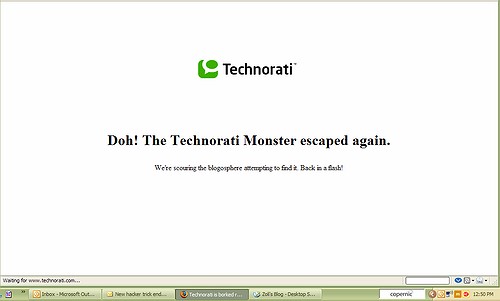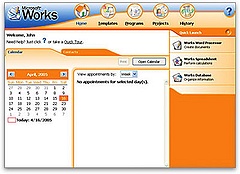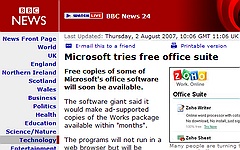As I’ve reported before, this morning several Gmail users found their accounts had 9030MB storage, instead of the typical 2.8G. A few hours later Google Blogoscoped and Google Operating System discovered that we can now purchase additonal storage on Google, via this account management screen. Here’s the price scheme they reported (annual prices):
 6 GB – $1.00
6 GB – $1.00- 25 GB – $75.00
- 100 GB – $250.00
- 250 GB – $500.00
If you think 6G for $1 per year is too good a deal, you’re right. By the time I tried it, the price for 6G was $20. The $1 price was not a typo though: see Philipp Lenssen’s screenshot and order receipt for the $1 pricing.
From $1 to $20 in minutes – that’s probably a world record in inflation…
Has anyone else grabbed it for $1?
Also see: Mashable!, Infectious Greed, Venturebeat, Official Google Blog, VentureBeat, ParisLemon.
Update: I can’t help but wonder about the timing: is Google trying to rain on Microsoft’s parade? They’ve just announced Windows Live SkyDrive– whith a whopping ![]() 500Mb of online storage. 500Mb sure goes a long way .. where’s the upgrade option?
500Mb of online storage. 500Mb sure goes a long way .. where’s the upgrade option?
Stories on SkyDrive: Read/WriteWeb, Mashable!, All about Microsoft, Windows Connected, One Microsoft Way , Insider Chatter, Don Dodge, jkOnTheRun, Dare Obasanjo aka Carnage4Life and Geek Speaker , TechCrunch.
Update (8/10): The Gmail storage counter stopped counting / growing. My Google apps accounts are frozen at 2048MB, non-branded gmail accounts at 2886MB. Michael Arrington said it right:
Today Google said they were not going to play that game any more. They effectively took their toys and went home. I never thought I’d see that.

 While most “average” email users are content with Gmai’s 2G storage, others are close to hitting the ceiling – see Paul Kedrosky’s rant on how
While most “average” email users are content with Gmai’s 2G storage, others are close to hitting the ceiling – see Paul Kedrosky’s rant on how 

 When it didn’t happen, they must have lost interest – the annual Money upgrades brought less and less new features or even bug fixes, and smart users started to skip releases between upgrades. Then trouble started left and right: weird things happened to my accounts beyond my control. Categorization? I’ve long given up on it, most of my downloaded data is associated with junk categories. The real bad part: data changed in existing accounts, very old transactions downloaded again into already reconciled months..etc. This is my bank account, my money we’re talking about! The very data I meticulously took care of while in my possession now got randomly changed. The only way to be really sure I have the right balances was (is) to go and verify them at the individual bank or broker sites.
When it didn’t happen, they must have lost interest – the annual Money upgrades brought less and less new features or even bug fixes, and smart users started to skip releases between upgrades. Then trouble started left and right: weird things happened to my accounts beyond my control. Categorization? I’ve long given up on it, most of my downloaded data is associated with junk categories. The real bad part: data changed in existing accounts, very old transactions downloaded again into already reconciled months..etc. This is my bank account, my money we’re talking about! The very data I meticulously took care of while in my possession now got randomly changed. The only way to be really sure I have the right balances was (is) to go and verify them at the individual bank or broker sites. ) and not even feel the need to apologize. It’s the absolute Cardinal Sin. And now this company wants me to put my trust in their services?
) and not even feel the need to apologize. It’s the absolute Cardinal Sin. And now this company wants me to put my trust in their services?

![Reblog this post [with Zemanta]](https://www.zoliblog.com/wp-content/uploads/HLIC/c3f6a73b6f73860cb3967d8190b33e5c.png)
 . From the
. From the 



 . How is it that after reading top blogs like
. How is it that after reading top blogs like  I strongly disagree – at least with the “always” part. In the late 80’s Works was my main productivity suite: I was happily crunching numbers, generating charts, including them as well as data from my database in word-processing documents. In other words, I had a perfectly working and lightweight integrated office suite at the time when Word, Excel and Powerpoint were part of a suite only in name, but moving data between them was a major pain. It had to be lightweight: my laptop had 640K memory (that’s K, not MB!) and two 720k floppy drives – no hard-disk at all. Yet it was happily churning away with Works.
I strongly disagree – at least with the “always” part. In the late 80’s Works was my main productivity suite: I was happily crunching numbers, generating charts, including them as well as data from my database in word-processing documents. In other words, I had a perfectly working and lightweight integrated office suite at the time when Word, Excel and Powerpoint were part of a suite only in name, but moving data between them was a major pain. It had to be lightweight: my laptop had 640K memory (that’s K, not MB!) and two 720k floppy drives – no hard-disk at all. Yet it was happily churning away with Works.

Recent Comments